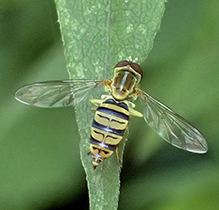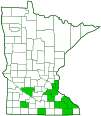maize calligrapher
(Toxomerus politus)
Conservation • Description • Habitat • Ecology • Distribution • Taxonomy
|
|
||||||||||||||
Description |
Maize calligrapher is an uncommon, small, typical hover fly. It occurs in North America, Central America, and South America. In the United States, it occurs east of the Great Plains and across the southwest from Texas to southern California. It also occurs in southern Canada from Nova Scotia to Ontario. Its spread into the Maritime Provinces is recent, just in the early 2000s. The larvae feed on the pollen and sap of corn. Adults are active in Minnesota from late July to mid-September. They are found in agricultural areas. They feed on the pollen of corn and sorghum, and they have been recorded on plantain. Adults are ¼″ to ⅜″ (7.0 to 9.0 mm) in length. The body is somewhat elongated, slender, mostly black, and shiny. The head is small, hemispherical, narrow, black, and shiny. The back of the head is strongly concave and closely appressed to the front of the thorax. On the male, the face is yellow, with dense white hairs on the sides but bare, shiny, and yellow in the middle. On the female, the face is brown in the middle. There are two large compound eyes on the sides of the head and three small simple eyes (ocelli) in a triangle on top of the head. The compound eyes are narrowly indented on the rear margin in the shape of a broad triangle. They are bare, with no erect hairs. On the male they abruptly converge and meet at the top of the head in front of the ocelli. On the female they do not meet. When viewed from the side, the antennae are in the middle of the head. They have three segments and are short, shorter than the head. The first two segments (scape and pedicel) are yellow. The third segment (flagellum) is orange at the base and is covered with yellow hairs. At the base of the flagellum there is a long, forward-pointing bristle (arista) on the upper side. The arista is bare, not plume-like. The protruding mouthpart (proboscis) is short and fleshy. The large front portion of the thorax (scutum) is black and shiny, with a very diffuse, yellow, narrow or broad, longitudinal stripe on each side. On the side of the thorax there are several yellow plates (sclerites), including a large spot before the wing bases, that together form a continuous yellow band from the front to the rear. On each side of the scutum, in the shoulder (humeral) area just behind the head, there is a small plate (postpronotum). The postpronotum is bare, with no hairs or bristles. Unfortunately, this is not visible without first removing the fly’s head. The small plate at the rear part of the thorax (scutellum) is yellow and is covered with black hairs. The abdomen is parallel sided and mostly black above and on the sides. On the male, the fifth abdominal segment (tergite) is visible from above, a feature that distinguishes the subfamily Syrphinae. On both sexes, the first tergite is short and mostly black, but with yellow on the front and sides. The second tergite has a narrow, unbroken, yellow band in the middle. The third and fourth tergites are yellow. There is a narrow, black, longitudinal stripe on each side close to the middle. Each stripe widens into an inverse L-shape near the front margin, approaching but not reaching the lateral margin, and each connects with a thick black band on the rear margin. The rear band widens at the lateral margins halfway to the front margin. The fifth tergite is similar, but the longitudinal stripes are merged together, not separated. Together, they form a squat T-shape. The legs are mostly yellow. The third segment (femur) and fourth segment (tibia) of each leg is yellow. The wings are mostly clear except for a region (stigma) on the leading edge that is lightly tinted smoky brown. There is a false (spurious) vein between the radius (R) and media (M) veins. The anal cell is long and is closed near the wing margin. The marginal, R5, and M2 cells are also closed. |
Size |
Total length: ¼″ to ⅜″ (7.0 to 9.0 mm) |
Similar Species |
Habitat |
Agricultural areas |
Ecology |
Season |
Late July to mid-September |
Behavior |
|
Life Cycle |
|
Larva Food |
Pollen and sap of corn |
Adult Food |
Pollen of corn and sorghum |
Distribution |
||
|
Sources TELFORD, H. S. 1939. The Syrphidae of Minnesota. Univ. of Minn. Agric. Exp. Sta. Tech. Bull. No. 140, 76 pp. |
|
| 4/2/2024 | ||
Occurrence |
||
Widespread but uncommon |
||
Taxonomy |
|
Order |
|
Suborder |
Brachycera |
Infraorder |
Cyclorrhapha |
Zoosection |
Aschiza |
Family |
Syrphidae (Hover Flies) |
Subfamily |
|
Tribe |
Syrphini |
Genus |
Toxomerus (calligrapher flies) |
The subfamily Syrphinae was traditionally divided into four tribes, Bacchini, Paragini, Syrphini and Toxomerini. The genus Toxomerus was placed in the tribe Toxomerini, and it was the only genus in that tribe. Several molecular studies between 2008 and 2016 showed that including the tribes Paragini and Toxomerini made the tribe Syrphini include only organisms from a common ancestor or ancestral group, but not all of the descendants of that ancestor or group – it was paraphyletic, and therefore invalid. A recent phylogenetic and evolutionary analysis of the subfamily Syrphinae (Mengual et al., 2022) showed that the family comprised just three major lineages of tribal rank, Melanostomini, Bacchini and Syrphini, and that Syrphini contained the former tribes Paragini and Toxomerini. |
|
Subordinate Taxa |
|
|
|
Synonyms |
|
Mesogramma polita Mesograpta polita Scaeva polita Syrphus anchoratus Syrphus cingulatulus Syrphus hecticus |
|
Common Names |
|
maize calligrapher |
|
Glossary
Arista
A large bristle on the upper side of the third segment of the antenna of a fly. Plural: aristae.
Femur
On insects and arachnids, the third, largest, most robust segment of the leg, coming immediately before the tibia. On humans, the thigh bone.
Ocellus
Simple eye; an eye with a single lens. Plural: ocelli.
Proboscis
The tube-like protruding mouthpart(s) of a sucking insect.
Scutellum
The exoskeletal plate covering the rearward (posterior) part of the middle segment of the thorax in some insects. In Coleoptera, Hemiptera, and Homoptera, the dorsal, often triangular plate behind the pronotum and between the bases of the front wings. In Diptera, the exoskeletal plate between the abdomen and the thorax.
Scutum
The forward (anterior) portion of the middle segment of the thorax (mesonotum) in insects and some arachnids.
Stigma
In plants, the portion of the female part of the flower that is receptive to pollen. In Lepidoptera, an area of specialized scent scales on the forewing of some skippers, hairstreaks, and moths. In other insects, a thickened, dark, or opaque cell on the leading edge of the wing.
Tergite
The upper (dorsal), hardened plate on a segment of the thorax or abdomen of an arthropod or myriapod.
Tibia
The fourth segment of an insect leg, after the femur and before the tarsus (foot). The fifth segment of a spider leg or palp. Plural: tibiae.
Visitor Photos |
||
Share your photo of this insect. |
||
This button not working for you? |
||
Babette Kis |
||
Toxomerus politus Maize calligrapher Toxomerus politus, maize calligrapher, photographed at Barnes Prairie, Racine Co. Wisconsin, on August 11, 2021. |
||
MinnesotaSeasons.com Photos |
||
|
||
|
||

Slideshows |
|

Visitor Videos |
||
Share your video of this insect. |
||
This button not working for you? |
||
|
Other Videos |
||
Exploring the World of Toxomerus politus (Maize Calligraphy) |
About
Aug 21, 2023 Toxomerus politus, commonly known as the maize calligrapher, is a species of hoverfly. It is known from North, Central and South America. Although little is known about the early stages of this species, associations with corn have been noted. The adults and likely the larvae feed on the pollen of the corn plants. |
WASP MIMIC HOVER FLY, Toxomerus politus tasting 9041493 |
About
Jul 28, 2020 WASP MIMIC HOVER FLY, Toxomerus politus tasting. Waterfall Glen FP, IL 9/17/2016 |
Toxomerus Politus |
About
Jun 16, 2023 Toxomerus politus es una especie de sírfido. Es conocido de América del Norte, Central y del Sur. Aunque se sabe poco sobre las primeras etapas de esta especie, se han observado asociaciones con el maíz. Los adultos y probablemente las larvas se alimentan del polen de las plantas de maíz. Google Translate: Toxomerus politus is a species of hoverfly. It is known from North, Central and South America. Although little is known about the early stages of this species, associations with corn have been observed. The adults and probably the larvae feed on the pollen of corn plants. |

Visitor Sightings |
||
Report a sighting of this insect. |
||
This button not working for you? |
||
Babette Kis |
Location: Barnes Prairie, Racine Co., WI Toxomerus politus, maize calligrapher, photographed at Barnes Prairie, Racine Co. Wisconsin, on August 11, 2021. |
 |
MinnesotaSeasons.com Sightings |
||
|

|
Created: 4/2/2024 Last Updated: © MinnesotaSeasons.com. All rights reserved. |

